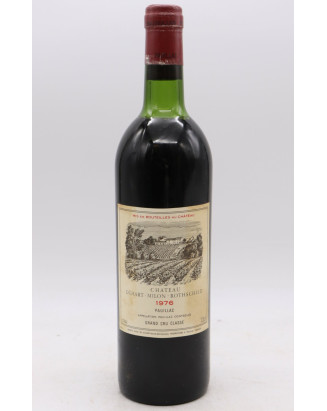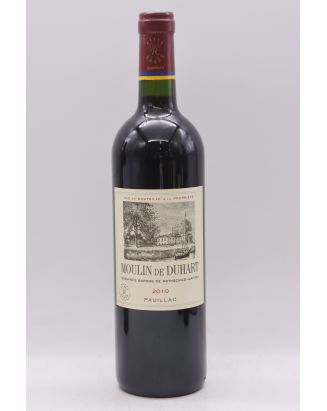










The history of Château Duhart-Milon dates back to the early 18th century, when the Milon vines were used to produce the second wine of Château Lafite. At that time, the estate was already part of the viticultural heritage of the de Ségur family, owners of several prestigious estates in Pauillac. It was under the direction of Marquis Nicolas-Alexandre de Ségur, nicknamed "the Prince of Vines" by Louis XV, that the vineyard gained its renown.
In 1855, during the famous classification of Médoc wines, Duhart-Milon was recognised as the only 4th Classified Growth in the commune of Pauillac, a sign of the exceptional quality of its terroir. However, at the beginning of the 20th century, a period of instability began. The estate changed hands several times, and the quality of the wines gradually declined. It was not until 1962, when the Rothschild family acquired Duhart-Milon, that the estate began a true renaissance. Under their management, significant work was undertaken to restore the vines, modernise the facilities, and restore Duhart-Milon to its place among the great wines of Bordeaux.
Today, the estate is still owned by Domaines Barons de Rothschild Lafite, and continues to be managed with a vision of excellence. With Saskia de Rothschild at its helm since 2017, Duhart-Milon is committed to sustainability, notably engaging in the organic conversion of its vineyards.
The 2009 vintage of Château Duhart-Milon received a 97/100 rating from Robert Parker, underlining the elegance and finesse of this Pauillac appreciated by connoisseurs.
Château Duhart-Milon benefits from an exceptional left bank terroir, situated in one of the most prized regions of Bordeaux: Pauillac, in the heart of the Médoc. The estate's 76 hectares of vines are planted on fine gravel soils, mixed with wind-blown sands and a limestone substratum, characteristics that give the wines their typicity and complexity.
The vineyard is composed of two main grape varieties: 67% Cabernet Sauvignon and 33% Merlot. This choice of grape varieties is perfectly adapted to the cool terroir of Duhart-Milon, particularly thanks to the northern exposure which allows for slow maturation of the grapes, thus offering wines that are both powerful and elegant. The average age of the vines is 30 years, and yields are limited to ensure optimal concentration of aromas and high fruit quality.
Meticulous work is carried out throughout the year to maintain the quality of the vineyard. The estate regularly undertakes drainage work, replanting, and purchases of neighbouring plots to consolidate its terroir. Each plot is vinified separately to preserve the integrity of its characteristics and to select only the best lots for wine production.
Winemaking at Château Duhart-Milon is a rigorous process that combines tradition and modernity. The estate recently modernised its facilities, with the construction of new cellars and modern vat rooms in 2020. This infrastructure allows for plot-by-plot vinification, thus offering optimal control over the quality of the wines.
The grapes are harvested by hand to select the best fruit. Once harvested, the grapes are vinified in temperature-controlled stainless steel vats, allowing for the freshness and purity of the aromas to be preserved. Malolactic fermentation also takes place in vats to ensure additional finesse.
The wines of Château Duhart-Milon are then aged for 14 to 16 months in French oak barrels, 50% of which are new. This barrel ageing contributes to the complexity and elegance of the wines, without masking the characteristics of the terroir. Thanks to this precise method, Duhart-Milon wines reveal a beautiful tannic structure and a perfect balance between power and finesse.
Château Duhart-Milon mainly produces two wines: the grand vin Château Duhart-Milon and its second wine, Moulin de Duhart. Each of these wines expresses the unique character of this exceptional estate.
Château Duhart-Milon
The grand vin of Château Duhart-Milon is often described as a classic model of the Pauillac appellation. Produced from the estate's oldest vines, it is distinguished by its great depth and aromatic intensity. Critics regularly praise its aromas of ripe black fruits, cedar and tobacco, as well as its tight tannic structure, which gives it excellent ageing potential.
Château Duhart-Milon is a serious wine that can be enjoyed after several years in the cellar. Enthusiasts particularly appreciate its ability to evolve over time, developing more complex notes of undergrowth, leather and spices over the decades.
Moulin de Duhart
Moulin de Duhart is the estate's second wine, made from the youngest vines of Duhart-Milon. Although it is a second wine, it benefits from the same careful attention as its big brother, both in the vineyard and in the cellar. Aged in barrels for a shorter period, Moulin de Duhart is distinguished by its softer and more accessible approach, while retaining a beautiful structure and refined balance.
This wine seduces with its aromas of crunchy red fruits, soft tannins and silky finish. It is ideal for earlier drinking, but also has good ageing potential.
Pauillac, one of the most prestigious appellations in the Médoc, ranks among the great Bordeaux wines, with remarkable vintages that have made history. Among the finest vintages are those from 1975, 1982, 1985, 1986, 1989 and 1990, renowned for their complexity and longevity. The years 1995, 1996, 2000, 2003 and 2005 also stand out for their richness and power. More recently, the vintages 2008, 2009, 2010, 2012, 2014, 2015, 2016, 2017, 2018, 2019 and 2020 have confirmed Pauillac's exceptional potential, offering wines that are both elegant and powerful, perfect for long-term cellaring.
Discover the full range of Fourth Classified Growths from Bordeaux, each one representing the richness of the Médoc's prestigious terroirs. In Saint-Julien, explore the wines of Château Beychevelle, Château Branaire-Ducru, and Château Talbot. In Pauillac, Château Duhart-Milon offers wines with the typical character of the appellation, while Château Lafon-Rochet in Saint-Estèphe provides robust vintages. In the Haut-Médoc, Château La Tour Carnet stands out, while Margaux's reputation is upheld by estates such as Château Marquis de Terme, Château Pouget, Château Prieuré-Lichine, and Château Saint-Pierre. Each of these estates reflects, in its own way, the unique identity of the Fourth Growths.
Château Duhart-Milon, thanks to the attention paid to its terroir and its meticulous winemaking methods, has established itself as a key player in Pauillac wines. Each wine, whether the grand vin or the second wine, accurately reflects the unique identity of this historic estate, while bearing the signature of excellence of Domaines Barons de Rothschild Lafite.